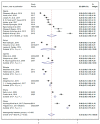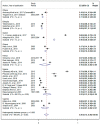Malaria and Helminthic Co-Infection during Pregnancy in Sub-Saharan Africa: A Systematic Review and Meta-Analysis
- PMID: 35564842
- PMCID: PMC9101176
- DOI: 10.3390/ijerph19095444
Malaria and Helminthic Co-Infection during Pregnancy in Sub-Saharan Africa: A Systematic Review and Meta-Analysis
Abstract
Malaria and helminthic co-infection during pregnancy causes fetomaternal haemorrhage and foetal growth retardation. This study determined the pooled burden of pregnancy malaria and helminthic co-infection in sub-Saharan Africa. CINAHL, EMBASE, Google Scholar, Scopus, PubMed, and Web of Science databases were used to retrieve data from the literature, without restricting language and publication year. The Joanna Briggs Institute's critical appraisal tool for prevalence studies was used for quality assessment. STATA Version 14.0 was used to conduct the meta-analysis. The I2 statistics and Egger's test were used to test heterogeneity and publication bias. The random-effects model was used to estimate the pooled prevalence at a 95% confidence interval (CI). The review protocol has been registered in PROSPERO, with the number CRD42019144812. In total, 24 studies (n = 14,087 participants) were identified in this study. The pooled analysis revealed that 20% of pregnant women were co-infected by malaria and helminths in sub-Saharan Africa. The pooled prevalence of malaria and helminths were 33% and 35%, respectively. The most prevalent helminths were Hookworm (48%), Ascaris lumbricoides (37%), and Trichuris trichiura (15%). Significantly higher malaria and helminthic co-infection during pregnancy were observed. Health systems in sub-Saharan Africa must implement home-grown innovative solutions to underpin context-specific policies for the early initiation of effective intermittent preventive therapy.
Keywords: co-infection; comorbidity; helminthic infections; pregnancy malaria; sub-Saharan Africa.
Conflict of interest statement
The authors declare no conflict of interest.
Figures








Similar articles
-
Comorbidity of Geo-Helminthes among Malaria Outpatients of the Health Facilities in Ethiopia: Systematic Review and Meta-Analysis.Int J Environ Res Public Health. 2021 Jan 20;18(3):862. doi: 10.3390/ijerph18030862. Int J Environ Res Public Health. 2021. PMID: 33498343 Free PMC article.
-
Plasmodium falciparum and soil-transmitted helminth co-infections among children in sub-Saharan Africa: a systematic review and meta-analysis.Parasit Vectors. 2016 Jun 15;9(1):344. doi: 10.1186/s13071-016-1594-2. Parasit Vectors. 2016. PMID: 27306987 Free PMC article.
-
Prevalence and Genotype Distribution of High-Risk Human Papillomavirus Infection Among Sub-Saharan African Women: A Systematic Review and Meta-Analysis.Front Public Health. 2022 Jul 8;10:890880. doi: 10.3389/fpubh.2022.890880. eCollection 2022. Front Public Health. 2022. PMID: 35875040 Free PMC article.
-
Prevalence and determinants of adolescent pregnancy in Africa: a systematic review and Meta-analysis.Reprod Health. 2018 Nov 29;15(1):195. doi: 10.1186/s12978-018-0640-2. Reprod Health. 2018. PMID: 30497509 Free PMC article.
-
Dengue Virus Infection in Sub-Saharan Africa Between 2010 and 2020: A Systematic Review and Meta-Analysis.Front Cell Infect Microbiol. 2021 May 25;11:678945. doi: 10.3389/fcimb.2021.678945. eCollection 2021. Front Cell Infect Microbiol. 2021. PMID: 34113579 Free PMC article.
Cited by
-
Quality and Integrated Service Delivery: A Cross-Sectional Study of the Effects of Malaria and Antenatal Service Quality on Malaria Intervention Use in Sub-Saharan Africa.Trop Med Infect Dis. 2022 Nov 9;7(11):363. doi: 10.3390/tropicalmed7110363. Trop Med Infect Dis. 2022. PMID: 36355905 Free PMC article.
-
Low and High Birth Weight in a Hospital Population in Qassim, Saudi Arabia: An Analysis of Clinical Cutoff Values.Children (Basel). 2024 Dec 4;11(12):1483. doi: 10.3390/children11121483. Children (Basel). 2024. PMID: 39767912 Free PMC article.
-
Malaria, Urogenital Schistosomiasis, and Anaemia in Pregnant Ghanaian Women.J Parasitol Res. 2023 Sep 29;2023:7500676. doi: 10.1155/2023/7500676. eCollection 2023. J Parasitol Res. 2023. PMID: 37808169 Free PMC article.
-
Screening for Resistant Bacteria, Antimicrobial Resistance Genes, Sexually Transmitted Infections and Schistosoma spp. in Tissue Samples from Predominantly Vaginally Delivered Placentae in Ivory Coast and Ghana.Pathogens. 2023 Jul 30;12(8):999. doi: 10.3390/pathogens12080999. Pathogens. 2023. PMID: 37623959 Free PMC article.
References
-
- World Health Organization . World Malaria Report 2020—20 Years of Global Progress & Challenges. World Health Organization; Geneva, Switzerland: 2020.
-
- World Malaria Report. 2020. [(accessed on 11 March 2022)]. Available online: https://www.wipo.int/amc/en/
-
- World Health Organization . Report of the WHO Strategic Advisory Group on Malaria Eradication i Malaria Eradication: Benefits, Future Scenarios & Feasibility A Report of the Strategic Advisory Group on Malaria Eradication. World Health Organization; Geneva, Switzerland: 2020.
-
- World Health Organization Guideline WHO Guidelines for Malaria—16 February 2021. [(accessed on 11 March 2022)]. Available online: http://apps.who.int/bookorders.
Publication types
MeSH terms
LinkOut - more resources
Full Text Sources
Medical

